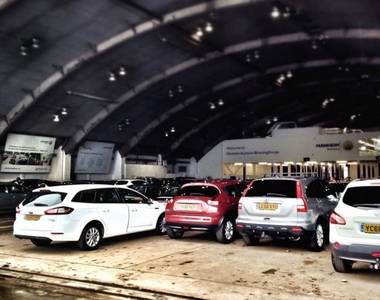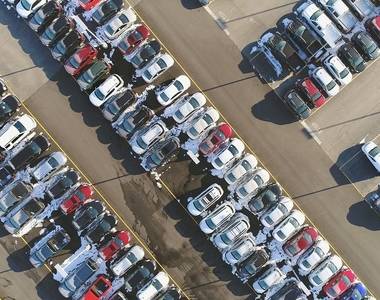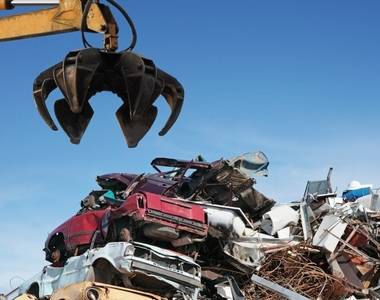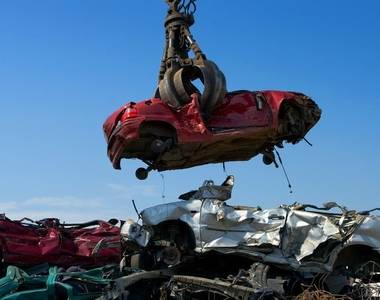Whether you’re browsing cars for sale or exploring insurance quotes online – you’ll almost certainly come across terms like ‘Cat S’, ‘Cat N’, ‘Cat D’, and ‘Cat C’.
For insurers and people in the motor trade, these are handy bits of jargon that give a quick overview the condition of a car – but to the average person, they don’t make a great deal of sense – especially when you find out that these codes have recently changed.
To help you make sense of salvage auction and insurance write off category codes, we’ve put together this straightforward guide that will explain everything you need to know. We’ve listed every current write off code with a detailed explanation of what it means – and we’ve even covered some older codes that you might still see popping up occasionally.
We’ve also answered a few common questions that relate to insurance write off codes too, including:
- Is Cat N car insurance more expensive?
- Are Cat D cars for sale from insurance companies?
- Should I buy a category S car?
- Do Cat N cars require a lot of work?
What are insurance write off categories?
When a car is damaged in an accident or incident, the insurance company that covers it will assess it to decide whether or not it’s worth repairing.
Rather than leave this decision up to the judgement of the assessor, there’s a strict set of criteria that are used. For example, an assessor will look for certain types of damage or measure how much overall damage has been done to the car.
If the car can be repaired, it will be – but if it repairing the car is not seen to be cost-effective, then it will be assigned a ‘write off category code’. These codes sometimes go by slightly different names – you might hear them referred to as ‘write off codes’, ‘insurance codes’, ‘salvage codes’ or similar.
Why are insurance write off categories used?
Realistically, no two damaged cars will be the same. Even two identical cars involved in similar accidents could end up with very different levels of damage – so insurers need a way of categorising cars based on their condition.
This is why write-off codes are used.
A code gives an insurer (or anyone else in the motor trade) an indication of the level of damage that’s been done to a car. Again, it doesn’t give any real detail about the type of damage that’s been done – after all, two Cat N insurance write-offs could be very different – but a write off code does give you a rough idea of the level of damage you can expect.
Salvage Categories
Let’s take a look at the different types of salvage and write off codes – starting with the most serious:
Cat A
Category A write off must be scrapped. There are no exceptions to this rule, and parts cannot be salvaged from any Cat A vehicle.
What is Cat A?
A Category A insurance write off is a vehicle that has suffered severe structural damage that cannot be repaired. The parts of the car that are designed to protect the occupants in a crash have been so badly damaged that they can no longer offer the intended protection.
Even if some parts are salvageable for reuse, it is illegal to do so. The entire vehicle must be scrapped at an Authorised Treatment Facility (ATF).
Cat A meaning
In reality, a Cat A car has been virtually destroyed by the accident or incident it’s been involved with. This is likely to be a heavy collision that has led to the structure of the car being bent or twisted out of shape.
It could also mean that the car has caught fire – or been set on fire. The extreme heat from a vehicle fire can severely compromise the strength of the car’s structure – making it unsuitable for use on the road.
You cannot buy or sell a Cat A vehicle – and you cannot buy or sell parts from a Cat A write off.
Cat B
Category B write off vehicles must be scrapped. There are no exceptions to this rule – however, parts can be recovered from a Cat B car to be used on other vehicles.
What is Cat B?
Like a Cat A vehicle, a Cat B car is one that has suffered significant structural damage that cannot be repaired. The chassis, body, and structural parts of the car are so badly damaged that they no longer offer occupants adequate protection was the car to crash.
Although parts cannot be salvaged from a Cat A vehicle – they can be from a Cat B car. This means salvageable parts can be bought and sold – but the bodyshell and the chassis must be scrapped at an ATF.
Cat B meaning
In real terms, a Cat B car is likely to have been in a severe accident or fire damage – but the nature of the incident means there are some parts that can be safely recovered for reuse.
To purchase a Cat B car, you must be registered as an Authorised Treatment Facility (ATF) that can officially handle cars that are not safe for the road. This is to safeguard against members of the public purchasing Cat B write-offs and returning them to the road in an unsafe condition. Members of the public can buy parts from a Cat B car that is being salvaged – but they cannot purchase the overall car or its chassis.
Cat S
A category S vehicle is one that has been structurally damaged in an accident – but this damage is fairly limited – meaning it is possible for the car to be put safely back on the road.
What is Cat S?
Just because a car is a write off doesn’t necessarily mean it’s damaged beyond repair – it simply means an insurer has decided it doesn’t make financial sense for them to have the work done. This is often the case with category S damage.
For example. If a car is worth £10,000 and it requires £6,000’s worth of main dealer work to get it back on the road, the insurance company will consider it a write off. However, a competent mechanic may be able to repair the car for a fraction of that cost – which means the car can go back on the road safely – while still being technically ‘a write off’.
Category S car meaning?
A Cat S write off is a vehicle that’s previously had structural damage – for example; damage around the crumple zones of the car or a chassis that’s been twisted. Since these parts are absolutely crucial to driver or passenger safety, a car that has been a Cat S write off will need to be inspected by an accredited engineer and re-registered with the DVLA before it goes back on the road.
Sometimes, the DVLA will issue a new ‘Q’ plate if a lot of work has been carried out – but most of the time, the car will retain a normal registration. Members of the public can buy Cat S vehicles – but it’s a good idea to have a pre-purchase inspection carried out before you do – just so you can be absolutely confident that all the work has been carried out to a high standard.
Cat N
A category N vehicle is one that has been involved in an accident – but has only incurred ‘non-structural’ damage.
What is Cat N?
When you consider quite how much that is that can go wrong with a car – it’s probably not surprising to find that most insurance write-offs in the UK are as a result of Cat N damage.
For example; if a vehicle’s engine has been damaged – or there’s been damage to electrical systems on the car, these things can be extremely expensive to put right. In cases like these, there’s no structural damage that would make the car dangerous to be in – just mechanical issues that mean the car is costly to fix.
Cat N cars do not require any inspection or re-registration after repair before they are returned to the road.
Cat N car meaning
Cat N damage is anything that isn’t considered structural – so mechanical issues, damage to the interior, problems with the electrical systems – and possibly even structural damage to body parts like bumpers or the roof panel.
When you consider how much it costs for an insurance company to have a repair carried out – it’s easy to see why so many Cat N cats appear on the market. For example, fixing body panels and respraying a £5,000 car could easily cost more than 50% of what the car is worth – so cosmetic damage could easily be enough to write off a car.
Since a Category N write off vehicle doesn’t need an inspection before it’s sold, it’s strongly recommended that you have a pre-purchase inspection carried out to make sure the car is safe and roadworthy before you buy it.
Older write-off category codes
In October 2017, the Association of British Insurers (ABI) decided that it was time to reassess the category codes that are given to vehicles when they’re written off.
Before this date, the categories were alphabetic; Category A, Category B, Category C, and Category D – in order of severity.
The rules and meanings around Category A and Category B write-offs are still exactly the same as they were before – but what about Cat C and Cat D? What’s happened to them?
In reality, Cat C and Cat D are very similar to Cat S and Cat N respectively – just with more of a focus on the damage to the car, as opposed to the cost of any repair. However, there are a few subtle changes to the definitions – so it’s worth looking at in a little more detail.
Cat C
If involved in an accident today, what was previously a Category C write off vehicle would now be called a Category S write off.
What is Cat C?
Strictly speaking, Category C used to mean that the cost of putting the vehicle back on the road actually exceeded the full value of the vehicle. Since this meant a big repair bill, it was fair to say that this usually meant the car had been structurally damaged.
Cat C meaning
It’s possible that you’ll still see Category C write-offs for sale today – since any vehicle that’s been written off must take its category designation with it until it’s finally scrapped. So, in real terms, you can expect a Cat C write off to have had serious structural work done to get it back into a road-going state.
If you’re considering purchasing a Cat C vehicle, you should make sure you know exactly what you’re dealing with – and, if possible, have a pre-purchase inspection carried out that will assess the work that’s been done to put it right.
Cat D
A Cat D car is a vehicle that’s been involved in an accident – and while the cost of the repair does not exceed that car’s overall value, the insurer has decided it is not economically viable to pay for it to be returned to the road.
What is Cat D?
So, a Cat D vehicle’s been damaged – but it could still be roadworthy with a little work. Although it might make sense for a member of the public to buy the car and carry out the work – an insurance company probably won’t. Again, insurance companies don’t carry out calculations for every damaged car – instead, they will simply have a cut-off point at which they are not willing to repair a car.
Therefore, a Cat D car might be worth £6,000 – but if the repairs are likely to cost more than £3,000 (50% of the value), then they will generally choose to just replace it.
Cat D meaning
Today, insurers consider the damage that’s been done to the car more than the cost to repair it – so a car that was previously a Cat D write off would now be considered a Cat N write off.
Why have we included it on this list then? Well, like Cat C cars, Cat D vehicles are still available to buy – because the insurance write off code is recorded on the car’s log book and will stay with it until it’s disposed of at an ATF. It’s rare to find a Car D car for sale now – but not impossible – so if you do, you should make sure you know exactly what you’re looking at, or book a pre-purchase inspection to avoid any nasty surprises.
What happens to cars when they’re written off?
As you can now probably tell, a written-off car could still have a long life ahead of it. Take a look at what might happen to a car after it’s been written off by an insurer:
Recycled
A lot of written-off cars quickly find themselves at ATF scrap yards – and this is always the case for Cat A cars. Although this is the end of the road for them in once sense – the UK now recycles over 93% of all the materials that make up a scrap car, so the materials often live on.
Clothing, furniture, jewellery, specialist flooring products, new car parts – these are just a tiny selection of things that materials from old cars can become when they’re recycled.
Since so much of your old car can be recycled, you might be surprised to find out quite how much a scrap car is worth. If you’ve got a written-off car that’s no longer fit for the road – use our scrap comparison service to see how much it could be worth when it’s broken down and recycled.
Auction
To make back some of the money that the claim has cost them – insurers will often sell written off cars back into the motor trade. This is usually done through specialist vehicle auctions.
Since breakers will hold ATF accreditation, they may be able to bid on Cat B vehicles – as well as safer Cat S and Cat N cars that are available for anyone to purchase. Depending on the write off category and the work involved, buyers may break the vehicle for parts – or may safely repair the vehicle for use again on the road.
A car sold at auction is likely to cost significantly less than the same vehicle prepared for the road and presented on a garage forecourt. If you’re curious to know how much your car might be worth at auction, you can use our valuation tool to compare a range of prices.
Is Cat N car insurance more expensive?
We’ve put together a detailed guide on category N insurance – but if you’re wondering if written-off cars are more costly to insure; the short answer is often yes. The same applies to category S insurance a lot of the time too.
Insurance companies use complex algorithms that consider thousands of factors when calculating your insurance costs. Unfortunately, many insurers think that a previously written off car is more likely to be involved in an accident in the future.
However, this isn’t always the case. At Car.co.uk, we work with a number of specialist insurance companies who – assuming you can prove that work has been carried out to a high-standard – will insure a Cat N car for the same cost as a non-written off car.
If you’re considering buying a Cat N car – or you need insurance for a Cat N car you already own, you can potentially save a lot of money by comparing prices using our free insurance comparison tool.
Are Cat D cars for sale from insurance companies?
Insurance companies don’t sell written off vehicles directly to buyers – instead, they generally use vehicle auctions to sell cars they have taken possession of.
So, it is possible to purchase Cat D (now known as Cat N) vehicles – and there are thousands of vehicle auctions held around the country that are accessible to members of the public. If you’d like to learn more about buying a car from an auction, you can read our detailed guide here.
Should I buy a category S write off car?
Buying a category S write off vehicle is a little different to buying a normal car – as you know there is going to be a significant amount of work needed before it can be driven on the road. Not only that – but you’ll need to make sure the repaired car is inspected and signed-off by the DVLA too.
So, a category S vehicle can represent a bargain – but you have to factor in the amount of work and money that’s going to be needed to get it back to a roadworthy condition. If you have lots of mechanical knowledge and access to specialist tools and facilities – you might be able to do some of this work yourself. However, if you don’t have any mechanical knowledge and you’re attracted by the price alone, you might want to reconsider.
Will a category N car require a lot of work?
With so many Cat N cars for sale today, it’s worth considering whether or not they’re good value. Some Cat N write off cars require minimal work to put them back on the road – but on the other hand, some require a lot of hard work and many replacement parts.
The title ‘Category N’ doesn’t give you any indication of how much work is going to be required to make a car safe and roadworthy again. In cases where cosmetic damage has meant the car is written off – you might be able to drive the car immediately; as long as you don’t mind some bumps and scratches. On the other hand, a car could be written off because it’s had a minor engine fire – which could mean a full engine rebuild and replacement components are needed.
Some Cat N cars require lots of work – some don’t. The only way to be 100% certain about what you’re buying is to get help from an experienced mechanic when you view the car – or get professional help with a pre-purchase inspection – so you’ve got all the information to work with before you commit to a purchase.











